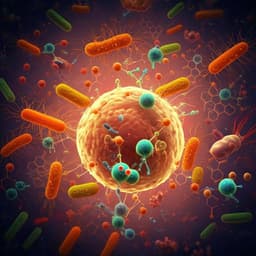
Agriculture
Fusaric acid mediates the assembly of disease-suppressive rhizosphere microbiota via induced shifts in plant root exudates
X. Jin, H. Jia, et al.
This groundbreaking study explores how tomato plants interact with the pathogen *Fusarium oxysporum* f. sp. *lycopersici* and rhizosphere microbiota. It sheds light on plant resistance linked to beneficial microorganisms and reveals how specific productions from FOL trigger systemic changes in rhizosphere composition, offering new insights into disease suppression. This exciting research was conducted by Xue Jin, Huiting Jia, Lingyi Ran, Fengzhi Wu, Junjie Liu, Klaus Schlaeppi, Francisco Dini-Andreote, Zhong Wei, and Xingang Zhou.
~3 min • Beginner • English
Introduction
Plants interact with a spectrum of rhizosphere microbes, and soil-borne pathogens such as Fusarium oxysporum cause major yield losses. Plant health emerges from the interplay among host metabolism, pathogens, and beneficial microbes. Plants can modulate rhizosphere microbiota, including recruiting beneficial taxa under biotic stress, consistent with the cry-for-help hypothesis. Genotype influences microbiome composition, and resistant versus susceptible cultivars can harbor distinct rhizobacterial communities. Pathogens deploy virulence factors (effectors, toxins) that can suppress plant immunity and potentially reshape rhizosphere communities. Fusaric acid (FA), a phytotoxic metabolite from Fusarium spp., is a known virulence factor. The study tests two hypotheses in tomato-FOL: (i) resistant and susceptible cultivars differ in their ability to recruit beneficial microbes upon pathogen infection; (ii) pathogen virulence factors (notably FA) alter microbial recruitment via effects on the host and/or microbes. Objectives were to compare rhizosphere microbiota changes after FOL across cultivars, determine FA’s effects on microbiota, and evaluate how root exudate shifts influence colonization by beneficial bacteria.
Literature Review
Prior work shows that plants actively modulate rhizosphere microbiota to antagonize pathogens, reduce damage, and enhance nutrient uptake. Under pathogen/herbivore attack, selective recruitment of beneficial microbes can occur. Plant genotype shapes rhizosphere communities; resistance traits often correlate with distinct microbiota. Pathogens can manipulate microbiomes directly through effector proteins with antimicrobial activity (e.g., Verticillium dahliae effectors VdAve1 and VdAMP2) or indirectly via host physiological changes. Fusaric acid is a Fusarium virulence factor, phytotoxic and associated with wilt symptoms. Root exudates are key drivers of microbiome assembly; stress-induced shifts in exudation can remodel microbial communities and leave soil-borne legacies. However, whether resistant vs. susceptible tomato cultivars differ specifically in recruiting beneficial microbes upon FOL infection, and how pathogen virulence factors modulate this recruitment via exudate changes, remained unclear.
Methodology
- Plant material and soils: Two tomato cultivars, susceptible D72 and resistant Z19. Natural field soil (Xiangyang County, Harbin, China) was characterized; sterile soil prepared by gamma irradiation. Plants grown in greenhouse with controlled conditions.
- Pathogen: F. oxysporum f. sp. lycopersici (FOL) race 1 wild-type isolate FOL06 maintained on PDA; conidial suspensions prepared per standard methods.
- Disease resistance in natural vs sterile soil: Unsplit-root pot experiment with both cultivars in natural or sterile soils. At 60 days, FOL applied at 1.0×10^6 conidia g−1 soil; disease assessed 30 days later; rhizosphere collected for FOL quantification.
- Split-root system: Roots divided to grow in two adjacent pots (local vs systemic). Treatments: control (both sides untreated) and FOL-inoculated on local side (1.0×10^5 conidia g−1). Disease recorded over time; at 6 days post inoculation (dpi), rhizosphere (local and systemic), roots, and root exudates collected. Systemic rhizospheres used for microbiota analysis and as inoculum for transplant assays.
- Rhizosphere transplant assays: Sterile background soil amended with 6% (w/w) rhizosphere inoculum from systemic pots or controls; new tomato plants grown and later challenged with FOL to test disease-suppressiveness transferred by microbiota.
- FA amendment experiments: Split-root in natural soil with FA drench (0.1 µg g−1 soil) on local side; systemic rhizospheres collected at 6 days for microbiota profiling and transplant assays; root exudates analyzed.
- Bacterial community profiling: 16S rRNA V3–V4 amplicon sequencing (Illumina MiSeq 2×300). QIIME pipeline, UCHIME chimera removal, UPARSE OTU clustering at 97% similarity, taxonomy via SILVA v132. β-diversity by Bray–Curtis PCoA and PERMANOVA. Differential abundance of OTUs/genera by DESeq2 with Benjamini–Hochberg correction.
- Isolation of culturable bacteria: From rhizospheres on multiple media; 573 isolates obtained; 39 isolates from six focal genera (Flavobacterium, Arthrobacter, Streptomyces, Lysobacter, Sphingobium, Sphingomonas) retained. 16S rRNA sequencing for taxonomic ID; mapping to OTUs. In vitro antagonism against FOL on PDA.
- Synthetic community (SynCom) assays: Six isolates selected to form SynCom (F179, Ar03, St81, Ly56, Sb87, Sm12). Unsplit-root pot assays in sterile soil: plants inoculated with bacteria (1.0×10^5 CFU g−1), then FOL (1.0×10^7 conidia g−1). Drop-out SynComs to assess contribution of each member. Disease severity scored; FOL abundance and FA content measured where indicated.
- Induced systemic resistance (ISR) tests: Split-root in sterile soil; one side inoculated with each isolate, other side challenged with FOL. Disease severity quantified; systemic roots sampled for qRT-PCR of defense genes (AOS, PR1a) normalized to ACTIN.
- Colonization assays: Split-root to test impact of FOL infection and FA on root colonization by isolates and SynCom. FA dose–response (0–50 µg g−1) effects on Sm12 in sterile and natural soil using rifampicin-resistant Sm12. Quantification by qPCR or CFU counts.
- FOL Δfub1 mutant: Deletion of FUB1 (reducing polyketide synthase) via fusion PCR and transformation with hygromycin selection; confirmation by PCR and HPLC-MS (loss of FA). Pathogenicity tested in pots; split-root assays comparing effects of WT vs Δfub1 on Sm12/Sphingomonas colonization.
- Root exudate analyses: Exudates collected from systemic pots (FOL-inoculated, FA-treated, or controls). HPLC-MS (UHPLC-QTRAP) profiling; OPLS-DA; metabolite identification via in-house library; normalization to root dry weight. Targeted comparisons of metabolites with VIP>1, |log2FC|>1, adjusted P<0.01.
- Exudate bioassays: Effects of bulk exudates on Sm12 growth and biofilm in vitro; effects of selected metabolites (e.g., fumaric acid, xylose, α-tomatine, tryptophan, rutin, 2-hydroxyglutaric acid, tyramine, leucine) at 10 µM on Sm12 growth/biofilm.
- FA toxicity assays: In vitro bacterial growth and biofilm formation across FA concentrations (0–50 µg ml−1). Tomato toxicity in pots across FA soil doses (0–50 µg g−1).
- Quantification: qPCR for FOL (SIX1 TaqMan) and bacterial genera (SYBR 16S). HPLC-MS quantification of FA in rhizosphere and cultures. Gene expression by qRT-PCR (2^−ΔΔCt). Statistical analyses in R: Welch’s t-test, ANOVA/Tukey HSD, PERMANOVA (vegan), DESeq2, OPLS-DA (ropls, mixOmics), multiple testing correction by Benjamini–Hochberg.
Key Findings
- Disease outcomes and microbiota contribution: Resistant cultivar Z19 showed greater resistance to FOL than susceptible D72 in both natural and sterile soils (Tukey’s HSD, P<0.05). Microbiota-mediated disease resistance (natural−sterile difference) was higher in Z19 than D72 (Welch’s t-test, P=0.004). In rhizosphere transplant assays, systemic rhizospheres from FOL-infected susceptible plants increased disease in susceptible recipients (e.g., S-FOL.Control disease index ~75 vs S-FOL.Sys ~88), whereas systemic rhizospheres from FOL-infected resistant plants decreased disease in resistant recipients (R-FOL.Control ~50 vs R-FOL.Sys ~33) and also reduced disease in susceptible recipients (all Tukey’s HSD, P<0.05).
- FA presence and effects: FA detected in FOL culture filtrates and in rhizospheres of locally inoculated pots but not systemic pots. FA-amended split-root and transplant experiments mirrored FOL patterns: in susceptible plants, FA-associated systemic rhizospheres increased disease (S-FA.Control ~75 vs S-FA.Sys ~88), while in resistant plants they decreased disease (R-FA.Control ~50 vs R-FA.Sys ~26) (Tukey’s HSD, P<0.05).
- Rhizosphere bacterial community shifts: PERMANOVA on systemic rhizospheres after FOL: cultivar R^2=0.220 (P<0.001), FOL infection R^2=0.118 (P<0.01), interaction R^2=0.126 (P<0.01). FOL increased 36 OTUs (29 in susceptible, 17 in resistant) and decreased 30 OTUs (24 in susceptible, 7 in resistant) (adjusted P<0.01). Notable taxa: Streptomyces OTUs enriched; Lysobacter, Sphingomonas, Flavobacterium OTUs decreased in susceptible. Some OTUs showed opposite responses across cultivars (e.g., Lysobacter OTU3848, Sphingomonas OTU1379, Sphingobium OTU4099 decreased in susceptible but increased in resistant; two Burkholderiaceae OTUs increased in susceptible but decreased in resistant). FA experiment PERMANOVA: cultivar R^2=0.204 (P<0.001), FA R^2=0.138 (P<0.001), interaction R^2=0.114 (P<0.01). FA and FOL co-affected the same OTUs in opposite directions across cultivars, notably Lysobacter, Sphingobium, Sphingomonas (co-clustered corroboration).
- Beneficial isolates and disease suppression: Among 39 isolates (six genera), most reduced Fusarium wilt in both cultivars (Tukey’s HSD, P<0.05). Sphingomonas sp. isolates had the strongest suppression. A six-member SynCom (F179, Ar03, St81, Ly56, Sb87, Sm12) reduced disease severity by 65.51% (susceptible) and 84.39% (resistant). Drop-out SynComs showed reduced efficacy; Sphingomonas Sm12 conferred the largest effect and was the only isolate with in vitro antagonism against FOL.
- Induced systemic resistance: In split-root ISR assays, all six isolates significantly suppressed disease on the opposite root side; Sm12 had the greatest effect. ISR correlated with elevated expression of defense genes AOS and PR1a in systemic roots (Tukey’s HSD, P<0.05). Isolates decreased FOL abundance and FA content in rhizospheres of FOL-challenged pots.
- Root colonization under pathogen/FA influence: In split-root assays, FOL increased colonization of Ar03 and St81 generally, but decreased Ly56, Sb87, and Sm12 in susceptible cultivar while increasing them in resistant cultivar (Tukey’s HSD, P<0.05). Similar patterns observed within SynCom. FA dose-response (0.1–1.0 µg g−1 soil) decreased Sm12/Sphingomonas abundance in susceptible rhizospheres but increased in resistant; high FA (10–50 µg g−1) decreased Sphingomonas in both cultivars and was toxic to tomato and Sm12 growth/biofilm in vitro.
- Genetic validation via Δfub1: FOL Δfub1 mutant lost FA production and showed reduced virulence. Compared to WT, Δfub1 had weaker negative effects on Sm12/Sphingomonas colonization in susceptible plants and weaker positive effects in resistant plants, supporting FA’s role in modulating recruitment.
- Root exudate mediation: Root exudates from systemic pots of FOL-infected susceptible plants inhibited Sm12 growth and biofilm; exudates from resistant plants stimulated them. FA-treated plants showed the same cultivar-specific exudate effects. OPLS-DA indicated distinct exudate profiles after FOL (susceptible: R^2X=0.470, Q^2=0.798; resistant: R^2X=0.502, Q^2=0.893). Twenty-eight metabolites were significantly altered. In susceptible: fumaric acid and xylose decreased; palmitic acid increased. In resistant: α-tomatine, tryptophan, rutin, 2-hydroxyglutaric acid, tyramine, leucine increased. FA amendments recapitulated these patterns. Individually, fumaric acid, xylose, α-tomatine, tryptophan, rutin, tyramine, and leucine (10 µM) stimulated Sm12 growth/biofilm (P<0.05). Root exudates did not significantly alter FOL growth, FA production, or FUB1 expression.
- Conceptual outcome: FOL-derived FA indirectly structures rhizosphere microbiota via cultivar-specific shifts in root exudates, enhancing recruitment of disease-suppressive taxa (e.g., Sphingomonas) in resistant plants while impairing such recruitment in susceptible plants. At higher doses, FA also directly inhibits beneficial bacteria and damages plants.
Discussion
The findings show that FOL infection systemically reshapes the rhizosphere microbiota, and that the virulence factor fusaric acid is a key mediator of these changes. Resistant and susceptible tomato cultivars differ markedly in how FOL/FA influences their rhizosphere: resistant plants recruit a disease-suppressive microbiota upon infection, while susceptible plants recruit a less suppressive or conducive microbiota. This differential recruitment is mechanistically linked to FA-induced shifts in root exudate chemistry that, in turn, modulate colonization by beneficial bacteria such as Sphingomonas sp. Sm12. The work addresses the proposed hypotheses by demonstrating both the cultivar-dependent recruitment of beneficial microbes after infection and the capacity of a pathogen virulence factor to alter this microbiome assembly indirectly through plant physiology. The study also reveals that beneficial taxa can protect plants via induced systemic resistance, reflected in defense gene activation, and that FA has dose-dependent direct antibacterial and phytotoxic effects that may further facilitate pathogen establishment. Overall, the tripartite interaction among plant genotype, pathogen-derived FA, and rhizosphere microbiota is decisive for disease outcomes, offering a mechanistic framework for microbiome-mediated disease suppression.
Conclusion
This study demonstrates that FOL-derived fusaric acid orchestrates the assembly of disease-suppressive rhizosphere microbiota via cultivar-specific alterations in tomato root exudates. Resistant cultivar Z19 responds to FOL/FA by enriching suppressive taxa (notably Sphingomonas), enhancing ISR and reducing disease, whereas susceptible D72 shows impaired recruitment of these key taxa. Genetic disruption of FA biosynthesis (Δfub1) reduces FOL virulence and attenuates its effects on beneficial microbe colonization, validating FA’s central role. The work advances understanding of how pathogen virulence factors indirectly shape plant microbiomes and provides a basis for leveraging beneficial microbes (e.g., SynComs) and plant genotypes to enhance disease suppression. Future research should test causality of specific exudate metabolites in vivo (e.g., biosynthetic gene knockouts/overexpression), explore broader microbial groups (fungi, oomycetes, mycorrhizae), dissect additional FOL virulence factors influencing microbiome assembly, and develop field-ready microbiome engineering strategies informed by these mechanisms.
Limitations
The study primarily focuses on rhizosphere bacterial communities; fungal, oomycete, and mycorrhizal components were not profiled and may contribute to disease outcomes. Causality for specific exudate metabolites was inferred from correlations and in vitro assays rather than in planta genetic manipulation of metabolite biosynthesis. While FA’s role was validated via Δfub1, other FOL virulence factors may also contribute to microbiome modulation and were not dissected. Most experiments were conducted in controlled greenhouse and split-root systems; field validation and long-term soil legacy effects were not assessed. Dose-dependent toxicity of FA indicates that effects may vary across environmental contexts and concentrations.
Related Publications
Explore these studies to deepen your understanding of the subject.







